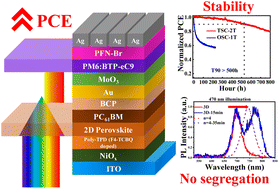Phase-segregation free quasi-2D perovskite/organic tandem solar cells with low Voc loss and efficiency beyond 21%†
Abstract
Perovskite/organic tandem solar cells (TSCs) have attracted increasing attention owing to their potential for high performance solution processable photovoltaics. However, Br/I mixed-halide perovskites as the active layer of wide band gap (WBG) front subcells suffer from inevitable photoinduced phase segregation. Here, quasi-2D perovskites free of phase-segregation are selected to act as the light-harvesting layer of the WBG front subcell due to their high operation stability under continuous illumination. A semi-empirical model was developed to estimate the practical limit of the photovoltaic parameters of the TSC devices with active layers of different band gaps and film thicknesses. By reasonable selection of an interface modification material as the hole transport layer, ultra-low open-circuit voltage (Voc) loss below 0.4 V was realized for the front subcell. The optimized TSC device exhibits a maximum PCE of 21.3% and high Voc of 2.06 V, together with excellent operation stability with T90 beyond 500 hours under the maximum power point condition in an air atmosphere.



 Please wait while we load your content...
Please wait while we load your content...